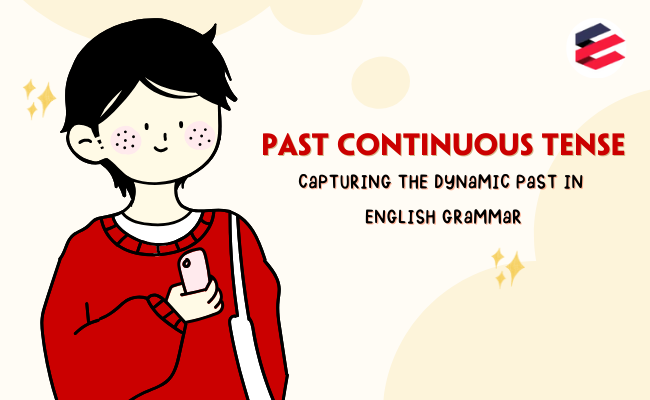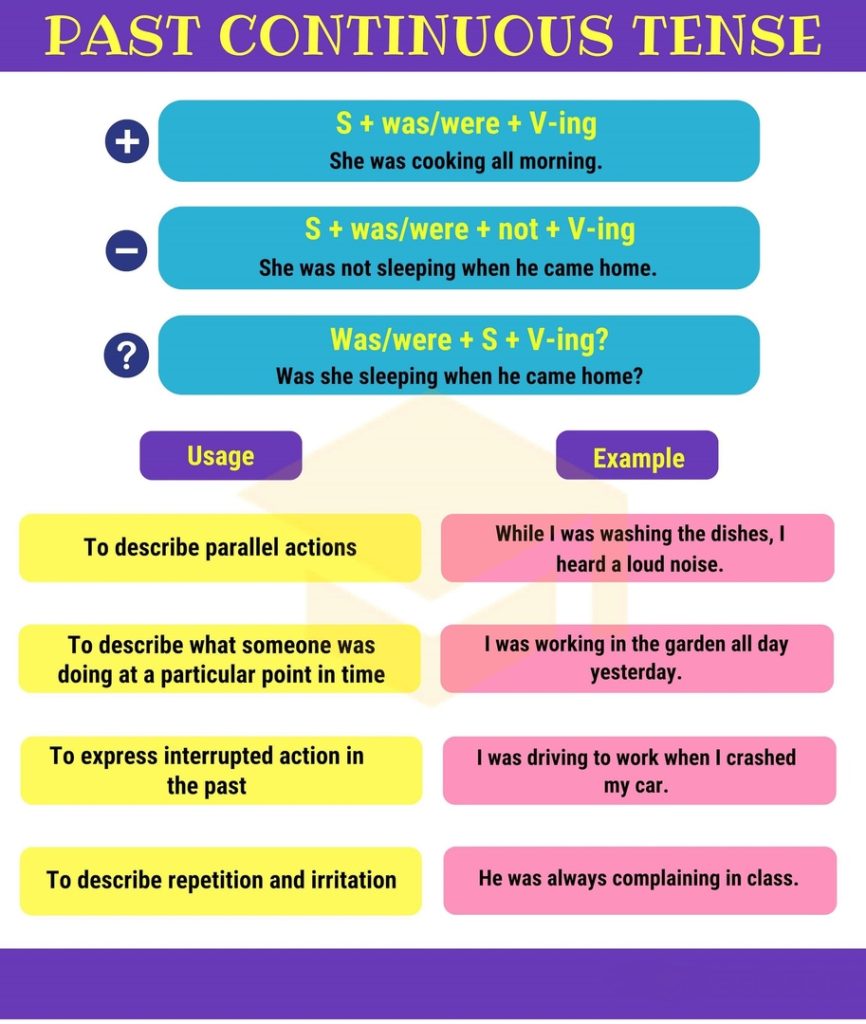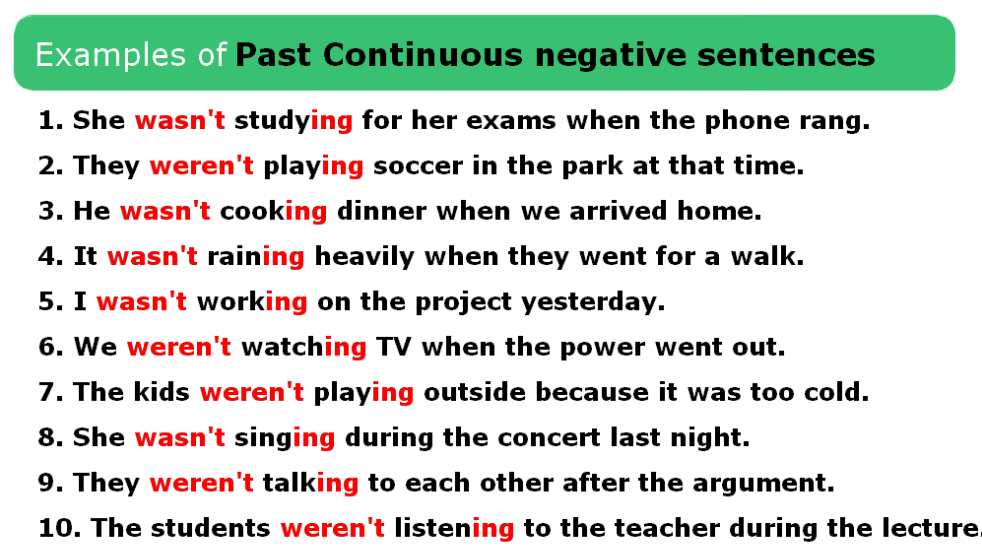Past Continuous Tense: Capturing the Dynamic Past in English Grammar
In the intricate landscape of English grammar, tenses stand as pillars, each supporting a unique dimension of expression. Among these, the past continuous tense emerges as a dynamic and intriguing facet, capturing the ongoing essence of actions in the past. Like a snapshot of a moving scene, the past continuous tense portrays actions that were in progress at specific moments in the bygone days, painting a vivid canvas of time.
This essay embarks on a journey through the realm of the past continuous tense, unraveling its structure, exploring its various applications, and illuminating its significance in both language and communication. As we delve into its intricacies, we uncover a past continuous tense that breathes life into narratives, adds depth to descriptions, and enriches our ability to convey the fluidity of the past.

1. Definition of past continuous tense
The past continuous tense, also known as the past progressive tense, is a grammatical form used to describe ongoing actions or events that were happening at a specific moment in the past. It emphasizes the duration, progress, or interruption of an action in the past, providing a sense of continuity to the narrative. This tense is formed using the past tense of the verb “to be” (was/were) and the base form of the main verb with the -ing suffix (e.g., was/were + verb + -ing). The past continuous tense helps convey a dynamic view of the past, allowing for a more vivid and detailed description of past actions or events in a given context.
2. Past continuous tense structure
The structure of the past continuous tense in English is formed using the past tense of the verb “to be” (either “was” or “were”) and the base form of the main verb with the -ing suffix. Here’s the breakdown of the structure:
2.1. Affirmative Form
Subject + was/were + Verb (base form + -ing)
I was reading a book.
They were playing football.
2.2. Negative Form
Subject + was not (wasn’t)/were not (weren’t) + Verb (base form + -ing)
I was not (wasn’t) reading a book.
They were not (weren’t) playing football.
2.3. Interrogative Form
Was/were + Subject + Verb (base form + -ing)?
Was I reading a book?
Were they playing football?
These structures help in constructing sentences in the past continuous tense, which is typically used to describe actions or events that were ongoing at a specific time in the past or actions that were happening around a particular moment in the past.
>> Suggested article: past simple tense

3. Usage of past continuous tense
The past continuous tense, also known as the past progressive tense, is used in English for several specific purposes:
3.1. Describing Ongoing Actions in the Past
The primary use of the past continuous tense is to describe actions, events, or situations that were in progress at a specific moment in the past. It emphasizes the duration and continuity of the action.
For example: “I was studying when the phone rang.” (The action of studying was in progress when the phone rang.)
3.2. Setting the Scene in Narratives
In storytelling or narrative writing, the past continuous tense is used to set the scene or describe background actions, creating a vivid and immersive atmosphere.
For instance: “It was raining heavily, and thunder was rumbling in the distance as she was walking home.”
3.3. Expressing Parallel Actions
It is used to describe two or more actions that were happening simultaneously in the past. This helps convey the idea that multiple events were occurring at the same time.
For example: “While he was cooking dinner, she was watching TV.”
3.4. Indicating Actions in Progress at a Specific Time
The past continuous tense can be used to specify an action that was happening at a particular time in the past. It often includes time expressions such as “at 3 o’clock,” “at that moment,” or “while.”
For example: “At 8 PM last night, I was having dinner.”
3.5. Politeness or Softening Statements
In more formal or polite communication, the past continuous tense can be used to soften statements, make requests, or express courtesy.
For instance: “I was wondering if you could help me with this.”
3.6. Expressing Irritation or Annoyance
In some cases, the past continuous tense can be used to express irritation or annoyance about an ongoing situation in the past.
For example: “He was constantly talking during the movie, which was really annoying.”
It’s important to note that the past continuous tense is often used in conjunction with the past simple tense to provide context and clarify the sequence of events in narratives or descriptions of the past. This combination of tenses allows for a more comprehensive portrayal of past actions and events.
3.4. Past continuous tense’s role in the IELTS test
The past continuous tense holds a notable role in the grammar for IELTS (International English Language Testing System), which evaluates a candidate’s proficiency in using the English language. Here’s how the past continuous tense is relevant in different sections of the IELTS test:
Speaking Section
In the IELTS Speaking test, candidates may use the past continuous tense to narrate past events, describe activities or experiences from a particular time in the past, or set the scene for a story. It allows them to showcase their ability to use varied tenses, including continuous tenses, to describe past actions in a fluent and accurate manner.
Writing Section
In the IELTS Writing test, specifically in Task 1 (Academic module), candidates might describe trends or changes that were happening at a particular time in the past using the past continuous tense. This could involve interpreting and describing data in a graph or chart that represents a historical or past scenario.
Additionally, in Task 2 of both the Academic and General Training modules, candidates might use the past continuous tense when providing examples or anecdotes to support their opinions or arguments.
Listening Section
The past continuous tense is encountered in the Listening section of the IELTS test in audio materials, including conversations, interviews, or lectures. Candidates need to understand this tense to comprehend and interpret events or activities described in the past, as well as to answer related questions accurately.
Reading Section
The Reading section of the IELTS test may present passages or texts that use the past continuous tense. Candidates must be able to recognize and understand this tense to grasp the timeline of events and actions, aiding comprehension and accurate answering of questions.

5. Past continuous tense exercise
Ex1: Fill in the blanks with the appropriate form of the verb in the past continuous tense:
While they __________ (cook) dinner, the guests arrived.
I __________ (read) a book when the power went out.
They __________ (play) football while it was raining.
He __________ (watch) TV while she was working on her assignment.
The kids __________ (swim) in the pool at this time yesterday.
Answers:
While they were cooking dinner, the guests arrived.
I was reading a book when the power went out.
They were playing football while it was raining.
He was watching TV while she was working on her assignment.
The kids were swimming in the pool at this time yesterday.
Ex2: Fill in the blanks with the appropriate form of the verb in the past continuous tense:
She __________ (sing) a song while he __________ (play) the guitar.
The students __________ (work) on their projects during the class.
We __________ (wait) for the bus when it __________ (start) raining.
While they __________ (have) dinner, the phone __________ (ring).
I __________ (walk) in the park when I __________ (see) the beautiful sunset.
Answer:
She was singing a song while he was playing the guitar.
The students were working on their projects during the class.
We were waiting for the bus when it started raining.
While they were having dinner, the phone was ringing.
I was walking in the park when I saw the beautiful sunset.
She reads a book.
They eat breakfast in the morning.
He writes a letter to his friend.
I listen to music on my way to work.
The dog barks loudly at strangers.
Answer:
She was reading a book.
They were eating breakfast in the morning.
He was writing a letter to his friend.
I was listening to music on my way to work.
The dog was barking loudly at strangers.
The essay thoroughly explores the past continuous tense, shedding light on its grammatical structure and multifaceted usage. It begins by defining the past continuous tense, showcasing its fundamental role in conveying ongoing actions or events in the past. The structure of the tense is elucidated, emphasizing the use of “was/were” and the base form of verbs with the “-ing” suffix.
The essay delves into the nuanced ways in which the past continuous tense is utilized, including its primary purpose of describing ongoing actions at specific moments in the past. It underlines its relevance in setting the scene in narratives, expressing parallel actions, pinpointing actions at a given time, conveying politeness, and highlighting annoyance or irritation.
Furthermore, the essay explores the crucial role of the past continuous tense in the IELTS test across its speaking, writing, listening, and reading sections. Proficiency in using this tense is essential to effectively communicate past experiences and comprehend auditory or written material in the test.
Overall, the essay underscores the significance of the past continuous tense as a vital linguistic tool that enriches communication, allowing for precise and vivid expression of events that were unfolding at distinct points in the past. Let’s take some IELTS practice test now!

